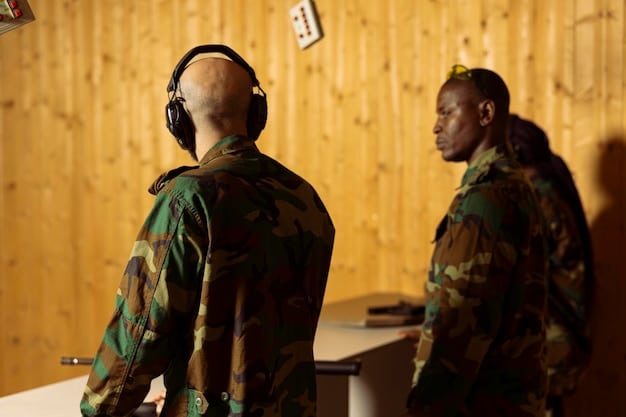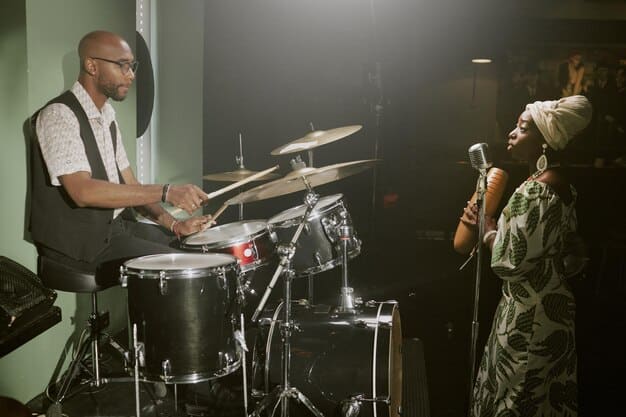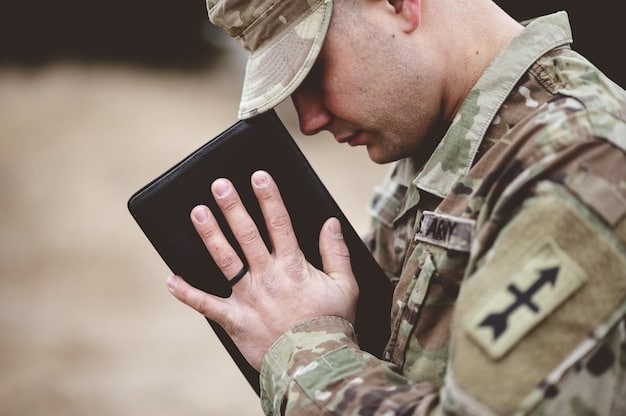How Military Music Has Evolved in the Last Decade: A Deep Dive

Military music has undergone a significant transformation in the last decade, influenced by technological advancements, evolving cultural landscapes, and the changing needs of modern military operations, leading to diverse genres and innovative applications.
The world of military music is more than just marches and anthems; it’s a dynamic reflection of societal changes and technological progress. Let’s explore how military music has evolved in the last decade, examining its vital role in morale, communication, and modern warfare.
The Enduring Role of Military Music
Military music has been an integral part of armed forces around the globe for centuries. Beyond simple entertainment, it serves several crucial functions. It boosts morale, facilitates communication, and provides a sense of unity and identity among soldiers.
Throughout history, military music has adapted to reflect the needs and values of its time. In recent years, this evolution has accelerated. Here’s how this aspect shaped over the last decade:
Traditional Music in the Modern Era
Traditional military music, like marches and patriotic songs, still holds significant importance. These pieces connect soldiers to their heritage and instill a sense of pride and duty.
Morale and Unit Cohesion
Music’s ability to uplift spirits and foster camaraderie remains invaluable. By sharing musical experiences, soldiers form stronger bonds that enhance unit cohesion and operational effectiveness.

Here are several aspects of how military music enhances the experience of the servicemen:
- It brings music from home abroad.
- It reminds the soldiers of their duty to family and home.
- It creates a sense of unity.
- It lifts spirits during prolonged periods of hardship.
The role of military music is essential to maintaining morale and unit cohesion. In the modern world, these benefits are as important as ever.
Technological Influence on Military Music
Technology has revolutionized virtually every aspect of modern life, and military music is no exception. Digitalization, social media, and innovative audio equipment have significantly reshaped how music is created, shared, and utilized within the military.
The integration of technology has opened new avenues for both performers and listeners. Music can now be more easily tailored to specific situations and audiences:
Digitalization and Music Production
Digital audio workstations (DAWs) and software have democratized music production. Now, even musicians with limited resources can create high-quality recordings.
Social Media and Music Sharing
Platforms like YouTube, Spotify, and SoundCloud have become vital tools for military bands and musicians to reach wider audiences. These platforms allow them to share their music and connect with troops around the world.

Here are how the tools available influence military music:
- The armed forces use music to recruit new soldiers.
- The creation of music videos has never been easier or cheaper.
- Access to music is ubiquitous using smart devices.
- Technology offers many new ways to use music innovatively during wartime.
Technology has ushered in a new era for military music, empowering musicians and enhancing the listening experience for soldiers.
Diversity in Military Music Genres
The range of musical genres employed by military forces has expanded dramatically over the past decade. This diversification reflects changing demographics within the military and an increasing recognition of the diverse musical tastes of service members.
Gone are the days when military music was exclusively limited to marches and patriotic anthems. Today, soldiers are exposed to a wide variety of influences. A sampling includes:
Rock and Pop in the Military
Contemporary rock and pop music have found their place within military culture. Bands often perform popular songs to boost morale and provide a sense of normalcy during deployments.
Hip-Hop and Electronic Music
Emerging genres like hip-hop and electronic music are also gaining traction. These styles resonate particularly well with younger service members and can be incorporated into training exercises and recruitment campaigns.
The increased inclusivity of musical elements allows for even further growth:
- Bands now perform music from their respective heritages.
- Soldiers are able to request music that lifts their morale.
- Composers now have virtually limitless flexibility in composition styles.
- The influence of more heritages introduces unique sonic qualities.
The shift towards greater diversity in military music genres has made it more relevant and appealing to a broader spectrum of service members.
Music Therapy and Mental Health in the Military
In recent years, the military has increasingly recognized the importance of mental health. Music therapy has emerged as a valuable tool for addressing issues such as PTSD, anxiety, and depression among veterans and active-duty personnel.
The integration of music therapy into treatment programs reflects a broader understanding of the mind-body connection. This aspect has seen tremendous improvements over the last ten years.
Benefits of Music Therapy
Music therapy can provide a safe and non-threatening outlet for emotional expression. It can help individuals process traumatic experiences, reduce anxiety, and improve overall well-being.
Implementation of Music Therapy Programs
Many military hospitals and rehabilitation centers now offer music therapy programs. These programs may include individual sessions, group therapy, and opportunities for creative expression through songwriting and performance.
Here are some of the ways that music is used as therapy:
- Encouraging creativity for expression.
- Soothing effects during recovery from physical trauma.
- Calming effects during mental health struggles.
- Offers an escape from daily routines and difficult struggles.
The growing emphasis on music therapy underscores the military’s commitment to supporting the mental health and well-being of its members.
The Use of Music in Military Training
Music is not only a source of entertainment and therapy; it also has practical applications in military training. It can be used to enhance physical performance, improve focus, and reinforce key concepts.
The strategic use of music in training leverages its ability to influence physiological and psychological states. Here is insight on how music is implemented in training today:
Music and Physical Performance
Upbeat music can increase motivation and endurance during physical exercises. Cadences and marching songs help synchronize movements, improving coordination and teamwork.
Music and Cognitive Enhancement
Certain types of music can improve alertness and concentration, making it easier for trainees to absorb new information. Music can also be used to create a memorable and engaging learning environment.
Music has proven essential for training, leading to continuous improvement:
- The rhythm supports standardized movements.
- It sets timing for key points during training exercises.
- It marks important times and keeps trainees engaged.
- It provides an auditory backdrop for instruction.
As military training continues to evolve, music will likely play an increasingly important role in optimizing learning outcomes.
The Future of Military Music
Looking ahead, the future of military music is poised for further innovation and adaptation. Emerging technologies, evolving cultural trends, and shifts in military doctrine will continue to shape its trajectory.
The next decade is likely to bring even more exciting developments in how music is used to support and enhance military operations. There are several trends emerging now in regard to music:
Virtual Reality and Immersive Music Experiences
Virtual reality (VR) technology could be used to create immersive music experiences for soldiers in remote locations. VR concerts and interactive music lessons could help combat feelings of isolation and promote mental well-being.
AI-Powered Music Composition
Artificial intelligence (AI) could be used to compose original music tailored to specific military needs. AI algorithms could analyze data on troop morale, operational requirements, and cultural preferences to create personalized soundtracks for various situations.
- AI can create original music.
- This music can be tailored for specific situations.
- VR experiences can enhance effects.
- Music can be tailored for mental support.
The future of military music promises to be both innovative and impactful. By embracing new technologies and adapting to evolving needs, military music will continue to play a vital role in the lives of service members worldwide.
| Key Point | Brief Description |
|---|---|
| 🎶 Role of Music | Boosts morale, facilitates communication, and fosters unity among soldiers. |
| 📱 Tech Influence | Digitalization, social media, and innovative audio equipment reshape music. |
| 🌍 Genre Diversity | Expanded genres include rock, pop, hip-hop, and electronic music. |
| 🧠 Music Therapy | Valuable tool for addressing PTSD, anxiety, and depression among veterans. |
FAQ
▼
Technology has enabled easier music production through digital software, and social media helps share military music widely, connecting with more troops. These platforms now empower new music and ideas.
▼
Music offers emotional expression and anxiety reduction. Music therapy in military hospitals aids in processing trauma, decreasing stress, and improving overall well-being. It promotes healing.
▼
Rock, pop, hip-hop, and electronic music have gained popularity in the military, reflecting the diverse tastes of modern service members. These genres lift morale and create unity.
▼
Music enhances physical performance, improves focus, and reinforces concepts during training. Tempo in music also helps trainees absorb new information, making learning engaging and memorable overall.
▼
Future innovations include virtual reality for immersive music experiences and AI-powered music composition tailored to military needs. These will improve wellness and cater to operational demands.
Conclusion
The evolution of military music in the last decade showcases significant innovation aimed at boosting morale, aiding mental health, and enhancing training. As technology advances and cultural tastes diversify, the future promises even more exciting developments in how music supports and enhances military operations globally.


